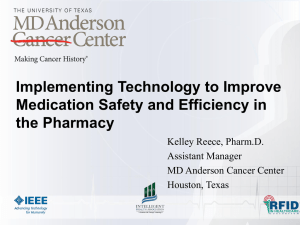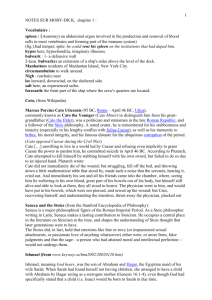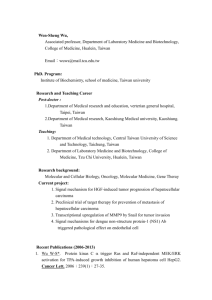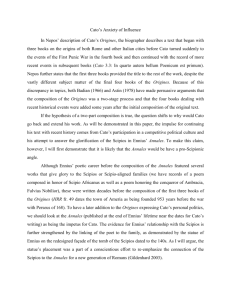Significant Association of Caveolin
advertisement
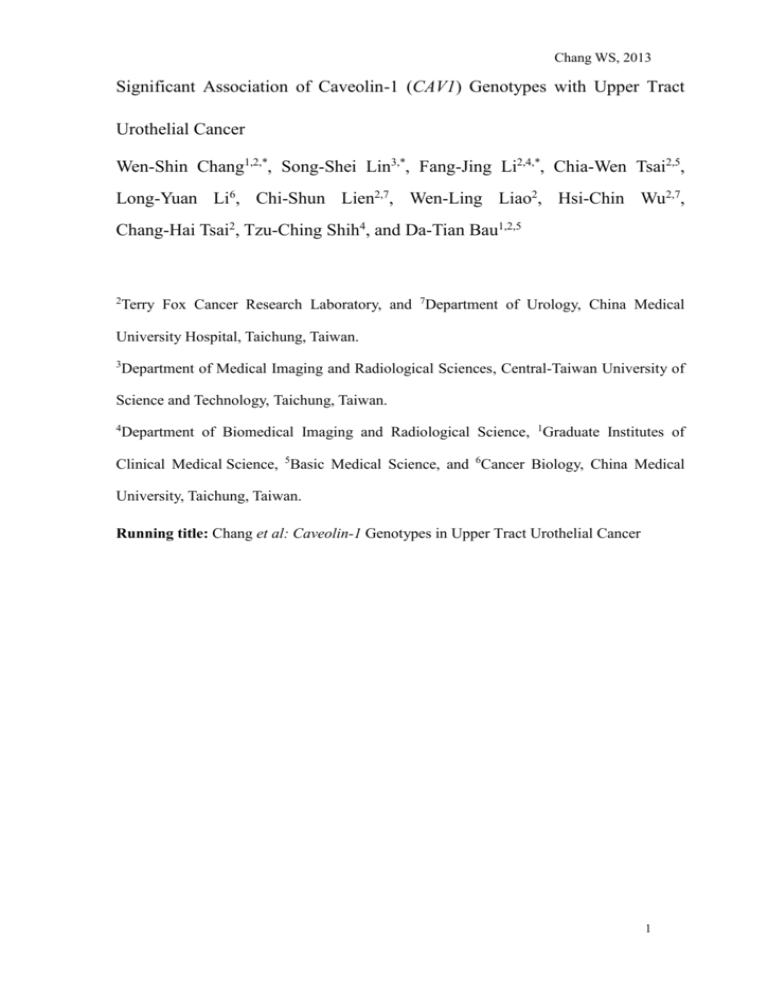
Chang WS, 2013 Significant Association of Caveolin-1 (CAV1) Genotypes with Upper Tract Urothelial Cancer Wen-Shin Chang1,2,*, Song-Shei Lin3,*, Fang-Jing Li2,4,*, Chia-Wen Tsai2,5, Long-Yuan Li6, Chi-Shun Lien2,7, Wen-Ling Liao2, Hsi-Chin Wu2,7, Chang-Hai Tsai2, Tzu-Ching Shih4, and Da-Tian Bau1,2,5 2 Terry Fox Cancer Research Laboratory, and 7Department of Urology, China Medical University Hospital, Taichung, Taiwan. 3 Department of Medical Imaging and Radiological Sciences, Central-Taiwan University of Science and Technology, Taichung, Taiwan. 4 Department of Biomedical Imaging and Radiological Science, 1Graduate Institutes of Clinical Medical Science, 5Basic Medical Science, and 6Cancer Biology, China Medical University, Taichung, Taiwan. Running title: Chang et al: Caveolin-1 Genotypes in Upper Tract Urothelial Cancer 1 Chang WS, 2013 Abstract. Aim: Upper tract urothelial cancer is of unusual high incidence in Taiwan and it is valuable to study the specificity of Taiwan and compare the counterpart findings in West countries. In literature, it was reported that single nucleotide variation of caveolin-1 gene (CAV1) plays an important role in other types of cancer risk, such as hepatoma, leukemia, nasopharyngeal carcinoma, oral, breast, bladder and prostate cancer, but no report about upper tract urothelial cancer. The aim of this study was to evaluate the association of six polymorphic genotypes of CAV1 with upper tract urothelial cancer within a Taiwanese population. Materials and Methods: A total of 218 patients with upper tract urothelial cancer and 580 of healthy controls in central Taiwan were genotyped by polymerase chain reaction and restriction fragment length polymorphism (PCR-RFLP) for six CAV1 polymorphic genotypes, C239A (rs1997623), G14713A (rs3807987), G21985A (rs12672038), T28608A (rs3757733), T29107A (rs7804372), and G32124A (rs3807992), of their association with upper tract urothelial cancer susceptibility. Results: The distribution of genotypes of CAV1 rs3807987 and rs7804372 were significantly different between cancer patient and control groups (p=0.0188 and 0.0090, respectively), while those for 2 Chang WS, 2013 CAV1 rs1997623, rs12672038, rs3757733 and rs3807992 were not significant (p>0.05). The haplotype analysis of the two polymorphic genotypes showed that compared with “GG/AT or GG/AA” haplotype of CAV1 rs3807987/rs7804372, people carrying GG/TT, AG/TT and AA/TT variants have significant increased risk of upper tract urothelial cancer risk (odds ratio, OR=1.61, 1.50 and 2.67, 95% confidence interval, CI=1.05-2.47, 1.50-1.90, 1.37-5.18, respectively). On the contrary, other haplotype variants conferred non-significant elevated risk. Conclusion: Our results suggested that individual and combined CAV1 rs3807987/rs7804372 genotypes being involved in predisposition to upper track urothelial cancer in Taiwanese population. Key Words: CAV1, polymorphism, genotype, upper track urothelial cancer. 3 Chang WS, 2013 Upper tract urothelial cancer (UTUC) is relatively rare in the West, where a ratio of 3:1:51 is reported for the incidence of urothelial cancer of the renal pelvis, ureter and bladder, respectively (1). However, it is usually elevated to the ratio of 1:2.08:6.72 in Taiwan, and it is valuable to start the upper tract urothelial cancer genomic study from Taiwan and then compare the counterpart findings in West populations. From the epidemiologically viewpoint, the elevated incidence of UTUC may be associated occupational with arsenic carcinogens, exposure, smoking, hypertension, long analgesics abuse, standing urinary obstructions, infection and Balkan nephropathy (2-7). Recent study has provided evidence that genetic polymorphisms may also predispose to the development of UTUC (8). Previous reports have suggested the gene for caveolin-1 (CAV1) may function as a tumor suppressor gene (9-12). Firstly, CAV1 mRNA and protein levels are down-regulated in various cancer cell lines, including in oncogene-transformed NIH 3T3 cells, in many human and mouse breast cancer cell lines, in primary human mammary gland tumors, and in transgenic breast cancer mouse cells (9-11). Secondly, CAV1 re-expression in breast cancer cell lines inhibits anchorage-dependent 4 Chang WS, 2013 growth in soft agar and reduces their invasive potential (10, 12). Last, CAV1 expression also reduces the migratory and invasive potential of MTLn3 cells, by preventing epidermal growth factor (EGF)-induced lamellipodia formation and reducing cell migration (13). In the human cell, CAV1 is the major structural and functional protein component of caveolae, which plays an important role in many signaling pathways, molecular transport, and cellular proliferation and differentiation. Before 2006, the genomic association of CAV1 with all types of cancer is not well studied and the analyses were mostly focused on the genetic mutations but not the polymorphisms. For instance in 2006, a study reported that mutations of CAV1 were associated with breast cancer risk (14). The evidence showed that genomic variation of CAV1 played a role in carcinogenesis, and led us to study whether different alleles of CAV1 are associated with UTUC, which has never been studied. Thus, the aims of the current study were to determine the genotypic frequency of six polymorphisms of the CAV1 at rs1997623, rs3807987, rs12672038, rs3757733, rs7804372, and rs3807992, and their contribution to UTRC susceptibility in Taiwan. Materials and Methods 5 Chang WS, 2013 Study population and sample collection. A total of 218 patients with upper tract urothelial cancer were recruited at China Medical University and Kaohsiung Medical University medical centers, all of whom were diagnosed by pathologic examination of specimens obtained by biopsy or surgical resection. The clinical and histopathologic information were collected from patient charts and pathologic reports. The information was reviewed, and the data were entered into the database. The tumor stage was assigned according to the TNM staging system (15), and the pathologic grade was determined according to the World Health Organization criteria (16). Five hundreds and eighty healthy individuals, who had been matched with the patients with age, admitted to the same hospital for health checkup and who had no previous diagnosis of urologic neoplastic disease or other malignancy were enrolled as controls. All the subjects enrolled were provided an informed consent and Human Research Committees of participating hospitals has approved this study. Genotyping conditions. Genomic DNA was prepared from peripheral blood leucocytes using a QIAamp Blood Mini Kit (Blossom, Taipei, Taiwan) and further processed according to our previous methods (17-23). Briefly, the following primers were used for CAV1 genotyping: for 6 Chang WS, 2013 rs1997623 genotyping, 5’-GTGTCCGCTTCTGC TATCTG-3’ and 5’-GCCAAGATGCAGAAGGAG TT-3’; for rs3807987 genotyping, 5’-CCTTCCAGTAAGCAAGCTGT-3’ 5’-CCTCTCAATCTTGCCATAGT-3’; and for rs12672038 genotyping, 5’-GGTGTCAGCAAGGCTATGCT-3’ 5’-CCAGACACTCAGAATGTGAC-3’; and for rs3757733 genotyping, 5’-GCTCAACCTCATCTGAGGCA-3’ 5’-GGCCTATTGTTGAGTGGATG-3’; and for rs7804372 genotyping, 5’-GCCTGAATTGCAATCCTGTG-3’ and 5’-ACGGTGTGAACACGGACATT-3’; and for rs3807992 genotyping, 5’-GGTGTCTTGCAGTTGAATG-3’ 5’-ACGGAGCTACTCAGTGCCAA-3’. and The following cycling conditions were used: one cycle at 94°C for 5 min; 35 cycles of 94°C for 30 s, 55°C for 30 s, and 72°C for 30 s; and a final extension at 72°C for 10 min. The PCR products were studied after digestion with AvrII, BfaI, HaeIII, Tsp509I, Sau3AI and NlaIII, restriction enzymes for CAV1 rs1997623 (cut from 485 bp C type into 170+315 bp T type), rs3807987 (cut from 268 bp A type into 66+202 bp G type), rs12672038 (cut from 251+43 bp A type into 153+98+43 bp G type), rs3757733 (cut from 298 bp T type into 100+198 bp A type), rs7804372 (cut from 336 bp A type 7 Chang WS, 2013 into 172+164 bp T type), and rs3807992 (cut from 213+142+67 bp A type into 142+118+95+67 bp T type), respectively. Statistical analyses. Two hundreds and eighteen cases and five hundreds and eighty controls were analyzed in the presented Tables. To ensure that the controls used were representative of the general population and to exclude the possibility of genotyping error, the deviation of the genotype frequencies of CAV1 single nucleotide polymorphism in the controls from those expected under the Hardy-Weinberg equilibrium was assessed using the goodness-of-fit test. Pearson’s chi-square test or Fisher’s exact test (when the expected number in any cell was less than five) was used to compare the distribution of the CAV1 genotypes between cases and controls. Cancer risk associated with the genotypes was estimated as odds ratio (ORs) and 95% confidence intervals (CIs) using unconditional logistic regression. All statistical tests were performed using SPSS for Windows (version 14.0; SPSS Inc., Chicago, IL, USA) on two-sided probabilities. The correlation between categorical variables was calculated for statistical significance using Pearson’s chi-square test and the threshold for significance was p≤0.05. 8 Chang WS, 2013 Results The frequency distributions of baseline clinical characteristics for the 218 upper tract urothelial cancer patients and 580 healthy controls are presented in Table I. Epidemiologically, there was no difference in the frequency distribution between the gender (p=0.4256) and age (p=0.4258) so the population was well matched (Table I). From the clinical and pathological viewpoints, tumors distributed in renal pelvic, ureter and multiple sites were 38.5%, 34.9% and 26.6%, respectively. About sixty percents were high grade, and 77.1% were of stages lower than pT3 (Table I). The frequencies of the genotypes for CAV1 rs1997623, rs3807987, rs12672038, rs3757733, rs7804372, and rs3807992 among the cancer patients and healthy controls are summarized and analyzed in Table II. Among the six polymorphic genotypes investigated, two of them, rs3807987 and rs7804372, were found to be differentially distributed between cancer and control groups (Table II). The distribution of GG, AG and AA genotypes of CAV1 rs3807897 were 54.1%, 33.0% and 12.8% among cancer patients, and 65.0%, 25.2% and 9.8% among healthy controls, respectively. The distribution of TT, AT and AA genotypes of CAV1 rs7804372 were 64.2%, 29.8% and 6.0% among 9 Chang WS, 2013 cancer patients, and 52.2%, 38.6% and 9.2% among healthy controls, respectively (Table II). As for rs1997623, rs12672038, rs3757733 and rs3807992, there was difference in the distribution of genotypes among cancer patients and controls (Table II). In addition, we have performed the allelic frequency analysis, and the frequencies of the alleles for CAV1 rs1997623, rs3807987, rs12672038, rs3757733, rs7804372, and rs3807992 among the cancer patients and healthy controls are summarized in Table III. The two SNPs of CAV1 found to be associated with upper track urothelial cancer risk in Table II, rs3807987 and rs7804372, were found to be associated with upper track urothelial cancer susceptibility, with higher frequency of A allele in rs3807987 and T allele in rs7804372 for the cancer group (Table III; P=0.0188 and 0.0090, respectively). As for the other four CAV1 genotypic sites, the distributions of their allele frequencies were not significantly different in controls and cancer patients (Table III). Considering the possible interactions between the two determinant CAV1 genotypes for upper track urothelial cancer susceptibility, the haplotypic distributions of CAV1 rs3807987 and rs7804372 were further analyzed (Table IV). We have set the lower risky genotypes as wild-type genotypes for haplotypic combination. Under this criteria, the “GG” 10 Chang WS, 2013 genotype for CAV1 rs3807987 and “AT or AA” for CAV1 rs7804372 were selected. Compared with the “GG/AT or GG/AA” haplotype of CAV1 rs3807987/rs7804372, the GG/TT, AG/TT and AA/TT groups have a significant higher risk of upper track urothelial cancer (crude OR=1.61, 1.50, and 2.67, respectively) (Table IV). After adjusting for age and gender, the significances became more obvious for the GG/TT, AG/TT and AA/TT groups with their individual ORs elevated to 1.68, 1.54 and 2.80, respectively (Table IV). Other two combinations, “AG/AT or AG/AA” and “AA/AT or AA/AA”, did not confer significantly altered cancer risk compared to the wild-type haplotype before or after adjusting for age and gender (Table IV). Discussion Urothelial carcinoma is the second most common cancer which usually arises from the urothelium with transitional cell differentiation, including that of the renal pelvis, ureter and bladder. In literature, there were a few of papers investigating the contribution of individual genomic variations to bladder cancer (24-28), while few to UTUC (8). The single nucleotide variations on CAV1 among people may determine their differential 11 Chang WS, 2013 expression of CAV1 and personal susceptibility to cancers. The supporting data comes from various types of cancer, including oral cancer (19), breast cancer (14, 21), colorectal cancer (29, 30), prostate cancer (23, 31, 32), bladder cancer (18), glaucoma (33, 34), nasopharyngeal carcinoma (22), and hepatocellular carcinoma (20). However, there is no report about UTUC. In this study, the genotypes of CAV1 of UTUC patients together with 580 controls (Table I) were examined. The distributions of CAV1 genotypes for rs3807987 and rs7804372 were differentially distributed among the UTUC and healthy control groups (Table II). In addition, the allelic frequencies of the two polymorphisms were also differentially distributed between the two groups (Table III). The results showed that the A allele of rs3807987 and T allele of rs7804372 were associated with higher risk for UTUC and the haplotype analysis suggested that individuals with GG/TT, AG/TT or AA/TT haplotype at rs3807987/rs7804372 were at higher risk of UTUC (Table IV). We have strengthened the sample size from 56 cases and 436 controls in previous study (35) to 218 cases and 580 controls (Table I). The enlarged sample size and the same trend of significant genotype distribution after age and lifestyle adjustments highlighted the value, accuracy and reliability of the overall findings (Table IV). 12 Chang WS, 2013 Epidemiologically, the highest incidence of bladder cancer has been found in black-foot disease endemic areas (36), and chronic drinking of arsenic-contaminated deep-well water (37) was associated with high bladder cancer prevalence in Taiwan. However, so far the different and similar causes between bladder cancer and UTUC have not been well understood. The chronic abuse of toxic traditional Chinese medicine was a serious threat to public health which may associate with high kidney-washing rate together with UTUC and/or bladder cancer in Taiwan. In the future, the alterations of CAV1 mRNA and protein expression levels in UTUC tissue would be revealed according to CAV1 genotypes among UTUC patients, and the intracellular mechanism related to carcinogenesis could be investigated after the fresh UTUC tissue samples were classified by their CAV1 genotypes. In conclusion, this is the first study showing CAV1 genotype is associated with UTUC risk. The A allele of CAV1 rs3807987 and T allele of CAV1 rs7804372 might become potential biomarkers for the early screening and risk prediction of UTUC. Acknowledgements We thank all the colleagues in China Medical University and Kaohsiung 13 Chang WS, 2013 Medical University medical centers for their technical assistance. We also appreciate the continuous contribution of our teammates Yi-Ting Chang, Hong-Xue Ji and Chieh-Lun Hsiao. This study was supported by research grants from the Terry Fox Cancer Research Foundation. 14 Chang WS, 2013 References 1 Carroll, P.: Urothelial carcinoma:cancers of bladder, ureter and renal pelvis. In: General Urology, 14th ed. Tanagho EA and McAninch JW (eds.). Philadelphia: Prentice-Hall Int, 353-371, 1995. 2 Mahony JF, Storey BG, Ibanez RC and Stewart JH: Analgesic abuse, renal parenchymal disease and carcinoma of the kidney or ureter. Aust N Z J Med 7: 463-469, 1977. 3 Mellemgaard A, Carstensen B, Norgaard N, Knudsen JB and Olsen JH: Trends in the incidence of cancer of the kidney, pelvis, ureter and bladder in Denmark 1943-88. Scand J Urol Nephrol 27: 327-332, 1993. 4 McLaughlin JK, Silverman DT, Hsing AW, Ross RK, Schoenberg JB, Yu MC, Stemhagen A, Lynch CF, Blot WJ and Fraumeni JF, Jr.: Cigarette smoking and cancers of the renal pelvis and ureter. Cancer Res 52: 254-257, 1992. 5 Chen CJ, Hsueh YM, Lai MS, Shyu MP, Chen SY, Wu MM, Kuo TL and Tai TY: Increased prevalence of hypertension and long-term arsenic exposure. Hypertension 25: 53-60, 1995. 6 Linet MS, Chow WH, McLaughlin JK, Wacholder S, Yu MC, Schoenberg JB, Lynch C and Fraumeni JF, Jr.: Analgesics and cancers of the renal pelvis and ureter. Int J Cancer 62: 15-18, 1995. 7 Liaw KL, Linet MS, McLaughlin JK, Yu MC, Schoenberg JB, Lynch CF, 15 Chang WS, 2013 Niwa S and Fraumeni JF, Jr.: Possible relation between hypertension and cancers of the renal pelvis and ureter. Int J Cancer 70: 265-268, 1997. 8 Lin HH, Ke HL, Hsiao KH, Tsai CW, Wu WJ, Bau DT and Chang LL: CCND1 1722 polymorphism and potential relevance to upper tract urothelial cancer. Anticancer Res 31: 1043-1047, 2011. 9 Koleske AJ, Baltimore D and Lisanti MP: Reduction of caveolin and caveolae in oncogenically transformed cells. Proc Natl Acad Sci U S A 92: 1381-1385, 1995. 10 Engelman JA, Lee RJ, Karnezis A, Bearss DJ, Webster M, Siegel P, Muller WJ, Windle JJ, Pestell RG and Lisanti MP: Reciprocal regulation of neu tyrosine kinase activity and caveolin-1 protein expression in vitro and in vivo. Implications for human breast cancer. J Biol Chem 273: 20448-20455, 1998. 11 Lee SW, Reimer CL, Oh P, Campbell DB and Schnitzer JE: Tumor cell growth inhibition by caveolin re-expression in human breast cancer cells. Oncogene 16: 1391-1397, 1998. 12 Fiucci G, Ravid D, Reich R and Liscovitch M: Caveolin-1 inhibits anchorage-independent growth, anoikis and invasiveness in MCF-7 human breast cancer cells. Oncogene 21: 2365-2375, 2002. 13 Zhang W, Razani B, Altschuler Y, Bouzahzah B, Mostov KE, Pestell RG and Lisanti MP: Caveolin-1 inhibits epidermal growth factor-stimulated 16 Chang WS, 2013 lamellipod extension and cell migration in metastatic mammary adenocarcinoma cells (MTLn3). Transformation suppressor effects of adenovirus-mediated gene delivery of caveolin-1. J Biol Chem 275: 20717-20725, 2000. 14 Li T, Sotgia F, Vuolo MA, Li M, Yang WC, Pestell RG, Sparano JA and Lisanti MP: Caveolin-1 mutations in human breast cancer: functional association with estrogen receptor alpha-positive status. Am J Pathol 168: 1998-2013, 2006. 15 Greene, F. L., Page, D. L., Fleming, I. D.: AJCC Cancer Staging Manual, 6th edition ed. New York: Springer-Verlag, 2002. 16 Epstein JI, Amin MB, Reuter VR and Mostofi FK: The World Health Organization/International Society of Urological Pathology consensus classification of urothelial (transitional cell) neoplasms of the urinary bladder. Bladder Consensus Conference Committee. Am J Surg Pathol 22: 1435-1448, 1998. 17 Wang CH, Lai YL, Chang WS, Wu KH, Lane HY, Chiu CF, Tsai FJ, Lin CC and Bau DT: Significant association of caveolin-1 single nucleotide polymorphisms with childhood leukemia in Taiwan. Cancer Genomics Proteomics 10: 75-79, 2013. 18 Bau DT, Chang CH, Tsai RY, Wang HC, Wang RF, Tsai CW, Yao CH, Chen 17 Chang WS, 2013 YS, Shyue SK and Huang CY: Significant association of caveolin-1 genotypes with bladder cancer susceptibility in Taiwan. Chin J Physiol 54: 153-160, 2011. 19 Bau DT, Tsai MH, Tsou YA, Wang CH, Tsai CW, Sun SS, Hua CH, Shyue SK and Tsai RY: The association of Caveolin-1 genotypes with oral cancer susceptibility in Taiwan. Ann Surg Oncol 18: 1431-1438, 2011. 20 Hsu CM, Yang MD, Tsai CW, Ho CY, Chang WS, Chang SC, Jeng LB, Tsai Y, Tsai FJ and Bau DT: The contribution of caveolin-1 genotype and phenotype to hepatocellular carcinoma. Anticancer Res 33: 671-677, 2013. 21 Liu LC, Su CH, Wang HC, Tsai CW, Chang WS, Ho CY, Wu CI, Li FJ, Lin CH, Lane HY and Bau DT: Significant association of caveolin-1 (CAV1) genotypes with breast cancer in Taiwan. Anticancer Res 31: 3511-3515, 2011. 22 Tsou YA, Tsai CW, Tsai MH, Chang WS, Li FJ, Liu YF, Chiu CF, Lin CC and Bau DT: Association of caveolin-1 genotypes with nasopharyngeal carcinoma susceptibility in Taiwan. Anticancer Res 31: 3629-3632, 2011. 23 Wu HC, Chang CH, Tsou YA, Tsai CW, Lin CC and Bau DT: Significant association of caveolin-1 (CAV1) genotypes with prostate cancer susceptibility in Taiwan. Anticancer Res 31: 745-749, 2011. 24 Primdahl H, Wikman FP, von der Maase H, Zhou XG, Wolf H and Orntoft TF: Allelic imbalances in human bladder cancer: genome-wide detection with 18 Chang WS, 2013 high-density single-nucleotide polymorphism arrays. J Natl Cancer Inst 94: 216-223, 2002. 25 Hoque MO, Lee CC, Cairns P, Schoenberg M and Sidransky D: Genome-wide genetic characterization of bladder cancer: a comparison of high-density single-nucleotide polymorphism arrays and PCR-based microsatellite analysis. Cancer Res 63: 2216-2222, 2003. 26 Chang CH, Chang CL, Tsai CW, Wu HC, Chiu CF, Wang RF, Liu CS, Lin CC and Bau DT: Significant association of an XRCC4 single nucleotide polymorphism with bladder cancer susceptibility in Taiwan. Anticancer Res 29: 1777-1782, 2009. 27 Chang CH, Wang RF, Tsai RY, Wu HC, Wang CH, Tsai CW, Chang CL, Tsou YA, Liu CS and Bau DT: Significant association of XPD codon 312 single nucleotide polymorphism with bladder cancer susceptibility in Taiwan. Anticancer Res 29: 3903-3907, 2009. 28 Selinski S, Lehmann ML, Blaszkewicz M, Ovsiannikov D, Moormann O, Guballa C, Kress A, Truss MC, Gerullis H, Otto T, Barski D, Niegisch G, Albers P, Frees S, Brenner W, Thuroff JW, Angeli-Greaves M, Seidel T, Roth G, Volkert F, Ebbinghaus R, Prager HM, Lukas C, Bolt HM, Falkenstein M, Zimmermann A, Klein T, Reckwitz T, Roemer HC, Hartel M, Weistenhofer W, Schops W, Rizvi SA, Aslam M, Banfi G, Romics I, Ickstadt K, Hengstler JG 19 Chang WS, 2013 and Golka K: Urinary bladder cancer risk in relation to a single nucleotide polymorphism (rs2854744) in the insulin-like growth factor-binding protein-3 (IGFBP3) gene. Arch Toxicol 86: 195-203, 2012. 29 Conde MC, Ramirez-Lorca R, Lopez-Jamar JM, Molero E, Ramirez-Armengol JA, Moreno Nogueira JA, Pascual MH, Ruiz A, Martin-Cordova CG, Real LM and Royo JL: Genetic analysis of caveolin-1 and eNOS genes in colorectal cancer. Oncol Rep 16: 353-359, 2006. 30 Yang MD, Tsai RY, Liu CS, Chang CH, Wang HC, Tsou YA, Wang CH, Lin CC, Shyue SK and Bau DT: Association of Caveolin-1 polymorphisms with colorectal cancer susceptibility in Taiwan. World J Gastrointest Oncol 2: 326-331, 2010. 31 Langeberg WJ, Tahir SA, Feng Z, Kwon EM, Ostrander EA, Thompson TC and Stanford JL: Association of caveolin-1 and -2 genetic variants and post-treatment serum caveolin-1 with prostate cancer risk and outcomes. Prostate 70: 1020-1035, 2010. 32 Sugie S, Tsukino H, Yamauchi T, Mukai S, Fujii M, Shibata N, Kuroda Y and Kamoto T: Functional polymorphism in the CAV1 T29107A gene and its association with prostate cancer risk among Japanese men. Anticancer Res 33: 1023-1027, 2013. 33 Wiggs JL, Kang JH, Yaspan BL, Mirel DB, Laurie C, Crenshaw A, Brodeur W, 20 Chang WS, 2013 Gogarten S, Olson LM, Abdrabou W, DelBono E, Loomis S, Haines JL and Pasquale LR: Common variants near CAV1 and CAV2 are associated with primary open-angle glaucoma in Caucasians from the USA. Hum Mol Genet 20: 4707-4713, 2011. 34 Thorleifsson G, Walters GB, Hewitt AW, Masson G, Helgason A, DeWan A, Sigurdsson A, Jonasdottir A, Gudjonsson SA, Magnusson KP, Stefansson H, Lam DS, Tam PO, Gudmundsdottir GJ, Southgate L, Burdon KP, Gottfredsdottir MS, Aldred MA, Mitchell P, St Clair D, Collier DA, Tang N, Sveinsson O, Macgregor S, Martin NG, Cree AJ, Gibson J, Macleod A, Jacob A, Ennis S, Young TL, Chan JC, Karwatowski WS, Hammond CJ, Thordarson K, Zhang M, Wadelius C, Lotery AJ, Trembath RC, Pang CP, Hoh J, Craig JE, Kong A, Mackey DA, Jonasson F, Thorsteinsdottir U and Stefansson K: Common variants near CAV1 and CAV2 are associated with primary open-angle glaucoma. Nat Genet 42: 906-909, 2010. 35 Chang CH, Wu HC, Ke HL, Lin HH, Shen WC, Sun SS, Tsai CW, Tsai RY, and Bau DT. The genetic role of cyclooxygenase 2 in ureter cancer in Taiwan. Adaptive Medicine 3: 99-105, 2011. 36 Hsu LI, Chiu AW, Huan SK, Chen CL, Wang YH, Hsieh FI, Chou WL, Wang LH and Chen CJ: SNPs of GSTM1, T1, P1, epoxide hydrolase and DNA repair enzyme XRCC1 and risk of urinary transitional cell carcinoma in 21 Chang WS, 2013 southwestern Taiwan. Toxicol Appl Pharmacol 228: 144-155, 2008. 37 Chiou HY, Chiou ST, Hsu YH, Chou YL, Tseng CH, Wei ML and Chen CJ: Incidence of transitional cell carcinoma and arsenic in drinking water: a follow-up study of 8,102 residents in an arseniasis-endemic area in northeastern Taiwan. Am J Epidemiol 153: 411-418, 2001. 22

